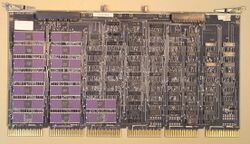FP11-A Floating-Point Processor
The FP11-A Floating-Point Processor is the optional hardware floating point unit for the PDP-11/34A (KD11-EA CPU). It consists of a single hex board, the M8267. It supports the full PDP-11 FP11 floating point.
The FP11-A uses a bank of 16 Am2901 Four-Bit Microprocessor Slice chips to perform all its computations; the main CPU is also used, to load and store operands in main memory, etc. Both are microcoded; the microcode width is 48 bits in each. The microcode for the CPU is contained on the CPU's M8266 card; the portion used for the FP11-A is the high half.
The FP11-A's connections to the KD11-EA include two over the back connectors; a 20-pin connector to the M8265 card of the KD11-EA, and a 10 pin connector to the M8266 card. (This was likely because the PDP-11/34 could be field-upgraded from a KD11-E CPU, which did not support the floating point unit, to a KD11-EA, which did - but its original DD11-P backplane was retained.)
Installation
This is mostly covered here. The latter over-the-top connector uses the connectors on the M8266 card which normally hold the maintenance cables to the KY11-LB Programmer's Console; in systems with a KY11-LB, the cables to the console will now connect to the M8267 card. (This is all necessitated because the FP11-A needs access to signals carried over the maintenance cables.)
For hardware debugging/repair, when the M8267 card is normally placed on a hex extender card to allow physical access to internal signals, a special W9042 Extender Board exists, to be used in place of the usual over the back connector, when so doing.
External links
- FP11-A floating-point processor user's guide (EK-FP11A-UG-001)
- FP11-A floating-point processor technical manual (EK-FP11A-TM-002)
- FP11-A Field Maintenance Print Set (MP00189) - contains the FP11-A microcode on pp. 42-89
